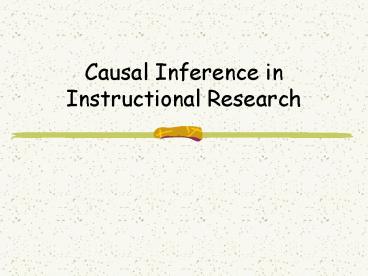Causal Inference in Instructional Research - PowerPoint PPT Presentation
1 / 18
Title:
Causal Inference in Instructional Research
Description:
A common sense view of causation (no review of different definitions) ... model consistency with data (i.e., can't ... Test the fit of the model to data. ... – PowerPoint PPT presentation
Number of Views:41
Avg rating:3.0/5.0
Title: Causal Inference in Instructional Research
1
Causal Inference in Instructional Research
2
Discussion Focus
- Research goal of understanding (not forecasting)
- Quantitative inquiry (not qualitative)
- A common sense view of causation (no review of
different definitions) - Available ER courses and resources (not other
departments or colleges)
3
Causation One Definition
- A causal relationship exists if the manipulation
of a cause will result in the manipulation of an
effect (Cook and Campbell, 1979, p. 36). - See Cook and Campbell for a comparison of
different philosophical positions on causation.
4
Logic of Causal Inference
- To infer that the correlation between two
variables (or the difference in mean outcomes for
two groups) is in part due to a causal effect,
one must - rule out alternative explanations (or rival
hypotheses), aka - eliminate all threats to internal validity,
aka - isolate the effect of one variable on the
other, controlling for all other possible causes.
5
Role of Instrument Reliability and Validity in
Causal Inference
- Construct validity required to ensure that an
empirical relationship reflects the putative
cause and effect - Reasonable instrument reliability required to
minimize the threat to statistical validity - ER courses e.g., EDF 5432
6
Overview of Study Designs for Causal Inference
- Experimental studies Researcher controls the
treatment intervention and the random assignment
of subjects to treatments. - Quasi-experimental studies Researcher controls
the treatment intervention, but cant assign
subjects randomly. Statistical control may be
used. - Non-experimental (aka correlational) studies
Researcher controls only the selection of
variables to be used for statistical control.
7
Experimental Studies (I)
- Payoff of random assignment Control the threat
of non-equivalent groups. - Remaining threats to internal validity due
primarily to focused inequities and to
differential mortality. - Reasons why an experiment may not be possible or
desirable include, e.g., impossibility of
manipulation (e.g., gender), ethical concerns
(e.g., exposure to disease), and need for quick
policy decisions.
8
Experimental Studies (II) Related ER Courses
- Research Design (EDF 5481)
- Statistical Analyses w/ ANOVA and ANCOVA
- EDF 5402 (classical)
- EDF 5401 (regression approach)
- EDF 5406 (multiple outcomes with MANOVA)
- Alternative analyses (e.g., nonparametric with
EDF 5410) - Note validity of causal inference not determined
by analysis method
9
Quasi-Experimental Studies (I)
- Introduces a new threat compared to experiments
nonequivalent groups - A range of possible nonequivalent (ne) group
designs from - Posttest-only with ne groups
- One group pretest-posttest design
- Control group design with pretest and posttest
- Interrupted time series design
10
Quasi-Experimental Studies (II) Related ER
Courses
- Research design (EDF 5481)
- Statistical analysis
- ANOVA and ANCOVA designs with increased attention
to statistical control for nonequivalent groups
(EDF 5401 and 5402) - Time series analysis (Stat department)
11
Non-experimental Studies (I)
- Bivariate correlation wo/ control
- Correlation does not imply causation (spurious
correlation) - Necessary but not sufficient condition for
causation - ER courses EDF 5400, 5410
- Bivariate correlation w/ control (e.g., partial
correlation)
12
Non-experimental Studies (II) Statistical
Control with Multiple Regression
- Results in valid causal inference when correctly
specified - Threat to validity of causal inference is
incorrect model specification (e.g., leaving out
important variables) - There is no empirical proof of correctness of a
model - Must rely on theoretical justification of model
13
Non-experimental Studies (III) Statistical
Control with Multiple Regression (Continued)
- Some limitations
- Only estimates the direct causal effects (i.e.,
no mediation) - No test of model consistency with data (i.e.,
cant falsify a model) - ER courses EDF 5401 (linear models)
14
Non-experimental Studies (IV) Structural
Equation Modeling (SEM)
- Hypothesize a causal model (see next slide). The
hypothesized direct effects imply indirect
effects. - Test the fit of the model to data.
- If fit not acceptable (i.e., if the model is
falsified), consider possible model revisions. - Once acceptable fit found, describe direct,
indirect, and total causal effects.
15
Path Diagram for Hypothesized Model
z
1
g
11
Aptitude
Motivation
b
31
( y
)
( x
)
1
1
g
31
Achievement
z
3
f
( y
)
b
12
3
21
g
b
22
32
SES
Study Habits
( x
)
2
( y
)
2
z
2
16
Non-experimental Studies (V) Structural Equation
Modeling (Cont.)
- Primary threat to validity of causal inference
incorrect model specification - No empirical test for correctness of model
- When the model fits the data, it can be concluded
that the model is consistent with the data, not
that the model has been proven true - ER course EDF 5401 (EDF 5409 changing to 100
HLM)
17
A COE Resource on Methods of Inquiry
- Go to College of Education web site and click on
Inquiry Skills - Help needed on revision and maintenance of site
18
Some Concluding Comments
- Strength of causal inference is a continuum, not
a dichotomy - Causal inference is possible with experimental,
quasi-experimental, and non-experimental
(correlational) studies - The strength of causal inference
- Depends on study and analysis logic allowing for
the elimination of alternative explanations, - Does not depend on the analysis method































